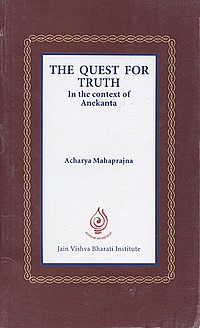 | About: |
| So far, all quests for truth have remained quests for the methods to get to truth. No goal can be accessed without first identifying the method with which to do so. Truth is a goal, knowledge, the method.
Bhagvan Mahavira's contemporary, Sanjay Velathiputha has said: If I do not know that an object is the truth, then how can I say it is the truth. If I do not know that it is not the truth, then how can I say it is not the truth? This is the skeptical stream of Indian philosophy. In Western philosophy the father of the skeptical method was Pyro (365-275 BC) He was the contemporary of Aristotle. Looking at the philosophical arguments and differences of opinion between philosophers ranging from Thalis to Aristotle, Pyro concluded that the journey towards truth is full of doubts. A mind without thoughts, a mind full of thoughts and concrete information based on the senses cannot constitute knowledge. There is no way of knowing the truth. To Kant both senses-based knowledge and thinking were necessary. Knowledge and truth are definite. Truth comes from the knowledge of the senses and definiteness from thoughts.
Bhagvan Mahavira gave two ways of getting to the truth: ati-indriya gyan or knowledge derived from extra sensorial perception and indriya gyan or knowledge derived from the senses. The knowledge gained from perception is that possessed by great saints or something which happens under extraordinary circumstances. It is not common. The common one is knowledge gained through the senses where the senses, the mind and the intellect participate. This knowledge is neither the truth nor the untruth. In relative terms it is the truth and in absolute terms it is untruth. Intellectual perception is neither the truth nor the untruth. In relative terms it is the truth and in absolute terms it is untruth. Therefore it is that anekanta is also called relativity. We explain or can explain anyone aspect or attribute of a substance. And then we fall into a quandary. If the object of our thoughts and expression are understanding and explaining, has only that one attribute, then our understanding and explanation represents the complete truth. But if the object has other attributes then our understanding and explanation have not got to the complete truth. To solve this problem, Jaina philosophers suggested the idea of anekanta. They said that with every thought we incorporate relativity and with every expression we add the word 'syat' meaning, 'in one respect...' This way both the speaker and the listener will be clear that what is being said is only one aspect of the truth and that the object has other aspects which have not been understood/ explored/ explained. Spoken language which is punctuated with the phrase, 'in one respect' is in Jaina philosophy called syadvaad. With the help of syadvaad and relativity we can understand anekanta and through anekanta we can get to complete truth. This method of accessing truth is a definitive and open minded way, free from doubts and dogmatism.
In this book I have tried to evaluate some problems on the anvil of anekanta. This holistic perspective is a significant tool for problem solving. The need is to understand the efficacy of this tool. Acharyashree Tulsi has been my inspiration. His one inspiration gives rise to many rays of thoughts. This book too is one resultant ray.
The book has been edited by Muni Dulahraj. He takes care of everything that it takes to bring out a book after it is written, thus unburdening me. Its new edition too will be rewarding and illuminating. With this hope and belief...
Acharya Mahaprajna
| |
| Author: | Acharya Mahaprajna |
| Publisher: | Jain Vishwa Bharati, Ladnun, India |
| Editor: | Muni Dulahraj |
| Translator: | Sudhamahi Regunathan under guidance of Muni Mahendra Kumar |
| Edition: | 2003 |
| Read online: | The Quest For Truth |
| Bookshop: | The Quest For Truth |
| Pages: | 207 |
| Dimensions: | 11.40 x 18.40 x 1.10 cm (W x H x D) |
| Weight: | 192 g |